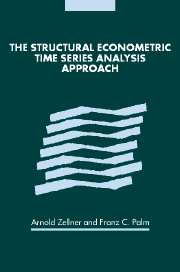Book contents
- Frontmatter
- Contents
- List of contributors
- Acknowledgments
- Introduction
- Part I The SEMTSA approach
- 1 Time series analysis and simultaneous equation econometric models (1974)
- 2 Statistical analysis of econometric models (1979)
- 3 Structural econometric modeling and time series analysis: an integrated approach (1983)
- 4 Time series analysis, forecasting, and econometric modeling: the structural econometric modeling, time series analysis (SEMTSA) approach (1994)
- 5 Large-sample estimation and testing procedures for dynamic equation systems (1980)
- Part II Selected applications
- Part III Macroeconomic forecasting and modeling
- Part IV Disaggregation, forecasting, and modeling
- Subject index
- Author index
- References
5 - Large-sample estimation and testing procedures for dynamic equation systems (1980)
Published online by Cambridge University Press: 24 October 2009
- Frontmatter
- Contents
- List of contributors
- Acknowledgments
- Introduction
- Part I The SEMTSA approach
- 1 Time series analysis and simultaneous equation econometric models (1974)
- 2 Statistical analysis of econometric models (1979)
- 3 Structural econometric modeling and time series analysis: an integrated approach (1983)
- 4 Time series analysis, forecasting, and econometric modeling: the structural econometric modeling, time series analysis (SEMTSA) approach (1994)
- 5 Large-sample estimation and testing procedures for dynamic equation systems (1980)
- Part II Selected applications
- Part III Macroeconomic forecasting and modeling
- Part IV Disaggregation, forecasting, and modeling
- Subject index
- Author index
- References
Summary
Introduction
In this chapter we consider large-sample estimation and testing procedures for parameters of dynamic equation systems with moving average error terms that are frequently encountered in econometric work (see, e.g., Quenouille 1957 and Zellner and Palm 1974). As pointed out in Zellner and Palm (1974), three-equation systems that are particularly relevant in econometric model building are (1) the final equations (FEs), (2) the transfer functions (TFs), and (3) the structural equations (SEs). In the present work, we specify these equation systems and develop large-sample “joint” or “system” estimation and testing procedures for each system of equations. These “joint” or “system” estimation procedures are iterative. They provide asymptotically efficient estimates of the parameters at the second step of iteration. The maximum likelihood (ML) estimator is obtained by iterating until convergence. The “joint” estimation methods provide parameter estimates that are more precise in large samples than those provided by single-equation procedures and the “joint” testing procedures are more powerful in large samples than those based on single-equation methods.
The aim of the chapter is to present a unified approach for estimating and testing FE, TF, and dynamic SE systems. In the chapter we use the results of previous work on the asymptotic properties of the ML estimator of the parameters of a dynamic model. We extend the recent work on efficient two-step estimation of dynamic models (e.g. Dhrymes and Taylor 1976, Hatanaka 1976, Reinsel 1976, 1977, Palm 1977a).
- Type
- Chapter
- Information
- The Structural Econometric Time Series Analysis Approach , pp. 201 - 240Publisher: Cambridge University PressPrint publication year: 2004



